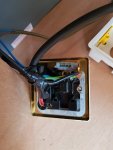PaulRainbow
Well-Known Member
There is an important recent change in regard to marina swimming inasmuch as SUP users are now often also boatowners and as such use their boats in their marina berths as very convenient launch points. Falling in (a lot !) is part of the learning curve. And many river based marinas will have water bordering on fresh especially after heavy rainfall.
This is one of the reasons I routinely fish immersed shorepower cables out of the water if I see them, as well as to reduce stray higher voltage AC current corrosion, which ignores the niceties of a GI, and can destroy underwater metalwork in short order.
Those are all good points Trevor.
I'm with you on fishing shore power cables out of the water

